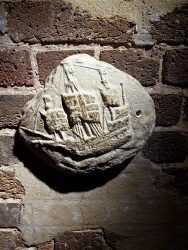Heather and I swapped hunting Elmers for a bit of history to continue our weekend’s adventure, catching a tube to the now bank infested docklands and the Museum of London Docklands.

Crest
East India Company
The museum is housed in a surviving example of the warehouses which once dominated the area. Entering one is confronted with shop and cafe and directions to begin your visit on the top floor. Up in the lift we went then, to begin what is a roughly chronological history of the Thames, and the docklands area in particular.

Gibbet
An ineffective deterant to others
The first few pieces aren’t actually that inspiring. There is an old boat and some examples of the trollies and tools once used in a warehouse such as we were standing in but its not for a little while the whole thing hits its stride. A large variety of objects tell the early story of the river’s trade, and the criminals that were attracted by the increasing activity—a gibbet is one notable item. The section of the building of Brunel’s tunnel of course attracting my attention.
The stride is quite quickly broken again by a large section on slavery. The despicable slave trade was obviously important for the commerce that developed but for a Museum of London it seemed to take something of a too general overview. It would have been nice to have focused more on how this directly affected the city. A book showing the horrors of child slaves in a plantation tells us a lot about how low humans will stoop in pursuit of profit but not a lot about London.

Found The Pub
No service
That slavery section takes up about a third of the top floor, so it isn’t until descending that the tale of the docks is moved forward. This is possibly the most successful section, chronically the change as empire and the flow of goods expanded, smaller wharfs being abandoned for huge scale purpose built docks hewn out of the land next to the river. It’s let down a bit by the strangely sterile and uninformative “sailortown”, probably an attempt to reproduce the street found more successfully in the main Museum of London.
Almost inevitably a large section of the second world war follows, more forgivable here than some other places as the docks were an obvious target for German bombing raids, greatly affecting them. More interesting though is what happened next, the docks being rebuilt from the ravages of war before falling into dereliction as ever increasing ship sizes made them obsolete and unusable. The old docks became transformed by the likes of Canary Wharf, the DLR and City Airport. While much of what was there was swept away, the remaining warehouses transformed into expensive apartments and offices, and the odd museum.

Secret Rivers
A large map showing them
That pretty much concluded the main part of the museum. Confusingly there isn’t much of general interest on the first floor and so we found ourself back at ground level and entering the temporary exhibition which had drawn us to the museum to start with. Secret Rivers concentrates on the rivers lost beneath the ever building London, some fairly well known whilst others aren’t. The displays began with a huge wall map detailing the location of these rivers in the modern city, before concentrating on a selection one by one, telling interesting tales associated with each. Whilst an obvious ploy that did result in a slighly air of disjointedness and probably a bit of repetition. It was still certainly enjoyable, though on emerging we were disappointed to discover a complete lack of tie-in merchandise in the shop. They lost the opportunity to sell a good book on the subject there.
So the Museum of London Docklands—worth a visit if something like Secret Rivers is there to catch the attention, but not as good as the main Museum of London or some of the other museums around.

Chest

Crest

Falmouth Model

Gibbet

Crest

High Street, Southwark

Swords

Found The Pub

Cosy Corner

Parrot

Secret Rivers

Comments and Pings